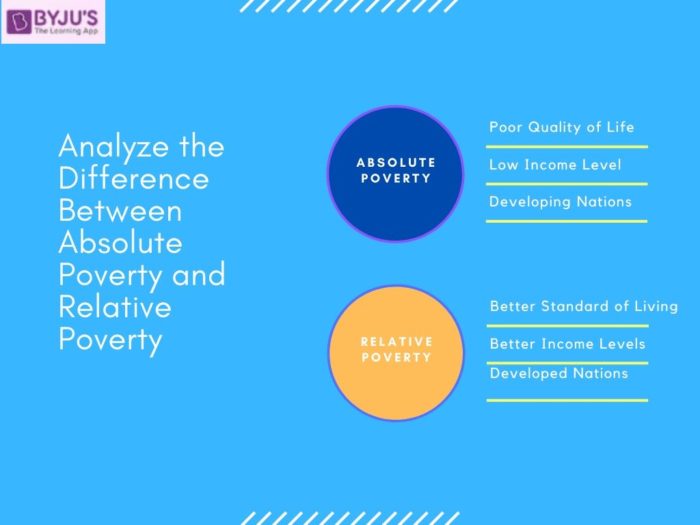Poverty is an economic condition where humans experience a lack of certain commodities essential for stable living.
Absolute Poverty and Relative Poverty are two terms used to measure this poverty level.
Absolute Poverty is used to describe a condition where an individual does not have the financial means to obtain commodities to sustain life.
Relative Poverty refers to the standard of living compared to economic standards of living within the same surroundings.

This article will further highlight the significant differences between absolute poverty and relative poverty within the context of the IAS Exam
Aspirants can find more Difference Between Articles, by visiting the linked page
The difference between Absolute Poverty and Relative Poverty is given in the table below:
Differences between Absolute Poverty and Relative Poverty
| Absolute Poverty |
Relative Poverty |
| Any person not in a position to obtain essential commodities like food, shelter and clothing are said to experience absolute poverty | Relative poverty does not concentrate on biological needs but rather makes a comparison between two people in the environment |
| Income Level is considered in Absolute Poverty | It is not considered when measuring relative poverty as a person will still be considered poor despite meeting his.her basic needs |
| Absolute poverty, however, does not include a broader quality of life issues or the overall level of inequality in society. What the concept fails to recognize is that individuals also have important social and cultural needs. | Although people living in relative poverty are to an extent well-off compared to those living in absolute poverty, they still cannot afford the same standard of life as other people in society. |
| Measured using Poverty Line | Measured Using the Gini-Coefficient and Lorenzo Curve |
| It is not possible to completely eradicate absolute | There is a small margin of success where its eradication is concerned |
| Quality of life is poor | Quality of life is marginally better as those living under relative poverty have access to health care services |
The concept of poverty is covered under the Economy segment of the UPSC Exams. Aspirants can find study materials related to this segment with the links given below:
- Causes of Poverty
- Poverty and Hunger
- List of Poverty Alleviation Programmes
- Strategy and Syllabus for UPSC Economics
- Notes for UPSC Indian Economy
Difference Between Absolute Poverty and Relative Poverty: UPSC Notes – Download PDF Here
Frequently Asked Questions about Absolute and Relative Poverty
What is an example of Relative Poverty?
What is an example of absolute poverty?
Candidates can find the general pattern of the UPSC Exams by visiting the UPSC Syllabus page. For more articles and exam-related preparation materials, refer to the links given in the table below:
Related Links

Comments